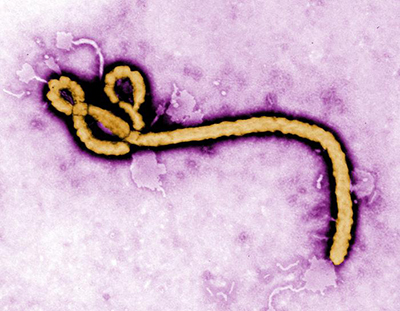Biological Agents - Overview | OSHA.gov (original) (raw)
Biological Agents
Overview
In Focus: Ebola

Frederick A. Murphy/CDC
The Democratic Republic of the Congo is experiencing a significant, ongoing Ebola outbreak. OSHA's Ebola webpage provides a comprehensive source of information for protecting workers from exposure to the Ebola virus, including airline crews who travel to affected regions.
Highlights
- Worker Protections Against Occupational Exposure to Infectious Diseases. OSHA. Compares universal precautions, standard precautions, and transmission-based precautions.
- Avian Influenza Protecting Poultry Workers at Risk. OSHA Safety and Health Information Bulletin (SHIB), (December 13, 2004).
- U.S. Postal Service: Better Guidance Is Needed to Ensure an Appropriate Response to Anthrax Contamination. Government Accountability Office (GAO) Report GAO-04-239, (September 2004).
- Managing Solid Waste Contaminated with a Category A Infectious Substance. U.S. Department of Transportation (DOT); U.S. Department of Labor (DOL); Environmental Protection Agency (EPA); U.S. Department of Defense (DoD); Centers for Disease Control and Prevention (CDC); and the Assistant Secretary for Preparedness and Response (ASPR), (August 2019). Provides consolidated, interagency guidance for employers and workers on best practices for safe waste handling throughout the waste cycle, from the point of waste generation through final disposition of treated waste products.
Biological agents include bacteria, viruses, fungi, other microorganisms and their associated toxins. They have the ability to adversely affect human health in a variety of ways, ranging from relatively mild, allergic reactions to serious medical conditions—even death. Some organisms, including various types of mold and Legionella bacteria, are found readily in the natural and built environment. Many are capable of spreading from person to person (e.g., bloodborne pathogens and influenza viruses), either directly or indirectly; some, including Zika virus, are transmitted by insect vectors. In some forms, biological agents can also be weaponized for use in bioterrorism or other crimes.
This page provides a listing of the Safety and Health Topics pages OSHA maintains for various biological agents and toxins. Each of these pages offers detailed information about the specific biological agent or group of agents on which it focuses, including sections on identifying possible worker health hazards and control measures to prevent exposures.

Anthrax. Anthrax is an acute infectious disease caused by a spore-forming bacterium called Bacillus anthracis. It is generally acquired following contact with anthrax-infected animals or anthrax-contaminated animal products.

Avian Flu. Avian influenza is a highly contagious disease of birds which is currently epidemic amongst poultry in Asia. Despite the uncertainties, poultry experts agree that immediate culling of infected and exposed birds is the first line of defense for both the protection of human health and the reduction of further losses in the agricultural sector.

Bloodborne Pathogens and Needlestick Prevention. OSHA estimates that 5.6 million workers in the health care industry and related occupations are at risk of occupational exposure to bloodborne pathogens, including human immunodeficiency virus (HIV), hepatitis B virus (HBV), hepatitis C virus (HCV), and others.

Botulism. Cases of botulism are usually associated with consumption of preserved foods. However, botulinum toxins are currently among the most common compounds explored by terrorists for use as biological weapons.

COVID-19. A new coronavirus that emerged from China in 2019 can cause pneumonia-like illnesses, with signs and symptoms including fever, cough, and shortness of breath.

Cytomegalovirus (CMV). Workers in childcare and healthcare facilities are among those at greatest risk for exposure to CMV, a common virus that affects tens of thousands of adults every year in the United States and is readily spread through contact with saliva and other body fluids from infected individuals.

Foodborne Disease. Foodborne illnesses are caused by viruses, bacteria, parasites, toxins, metals, and prions (microscopic protein particles). Symptoms range from mild gastroenteritis to life-threatening neurologic, hepatic, and renal syndromes.

Hantavirus. Hantaviruses are transmitted to humans from the dried droppings, urine, or saliva of mice and rats. Animal laboratory workers and persons working in infested buildings are at increased risk to this disease.

Legionnaires' Disease. Legionnaires' disease is a bacterial disease commonly associated with water-based aerosols. It is often the result of poorly maintained air conditioning cooling towers and potable water systems.

Measles. Measles is a vaccine-preventable virus that is highly contagious. Unvaccinated people who are exposed to the virus can spread it to other susceptible people. The virus can cause serious illness in children.

Middle East Respiratory Syndrome (MERS). MERS is a potentially fatal, emerging respiratory disease caused by a novel coronavirus that primarily affects the lungs and breathing passages. MERS was first reported in Saudi Arabia in 2012, and at least 25 other countries have reported confirmed cases of MERS.

Molds. Molds produce and release millions of spores small enough to be air-, water-, or insect-borne which may have negative effects on human health including allergic reactions, asthma, and other respiratory problems.

Plague. The World Health Organization reports 1,000 to 3,000 cases of plague every year. A bioterrorist release of plague could result in a rapid spread of the pneumonic form of the disease, which could have devastating consequences.

Ricin. Ricin is one of the most toxic and easily produced plant toxins. It has been used in the past as a bioterrorist weapon and remains a serious threat.


Smallpox. Smallpox is a highly contagious disease unique to humans. It is estimated that no more than 20 percent of the population has any immunity from previous vaccination.

Tularemia. Tularemia is also known as "rabbit fever" or "deer fly fever" and is extremely infectious. Relatively few bacteria are required to cause the disease, which is why it is an attractive weapon for use in bioterrorism.


Zika Virus. Zika virus is most commonly spread through the bites of infected mosquitoes in areas with ongoing viral transmission. However, it can also be passed from person to person through sharps injuries (e.g., needlesticks) and other exposures to infectious blood, body fluids, and materials. Outdoor workers in areas with active transmission, along with those in laboratories handling samples of Zika virus, remain at the greatest risk of infection.